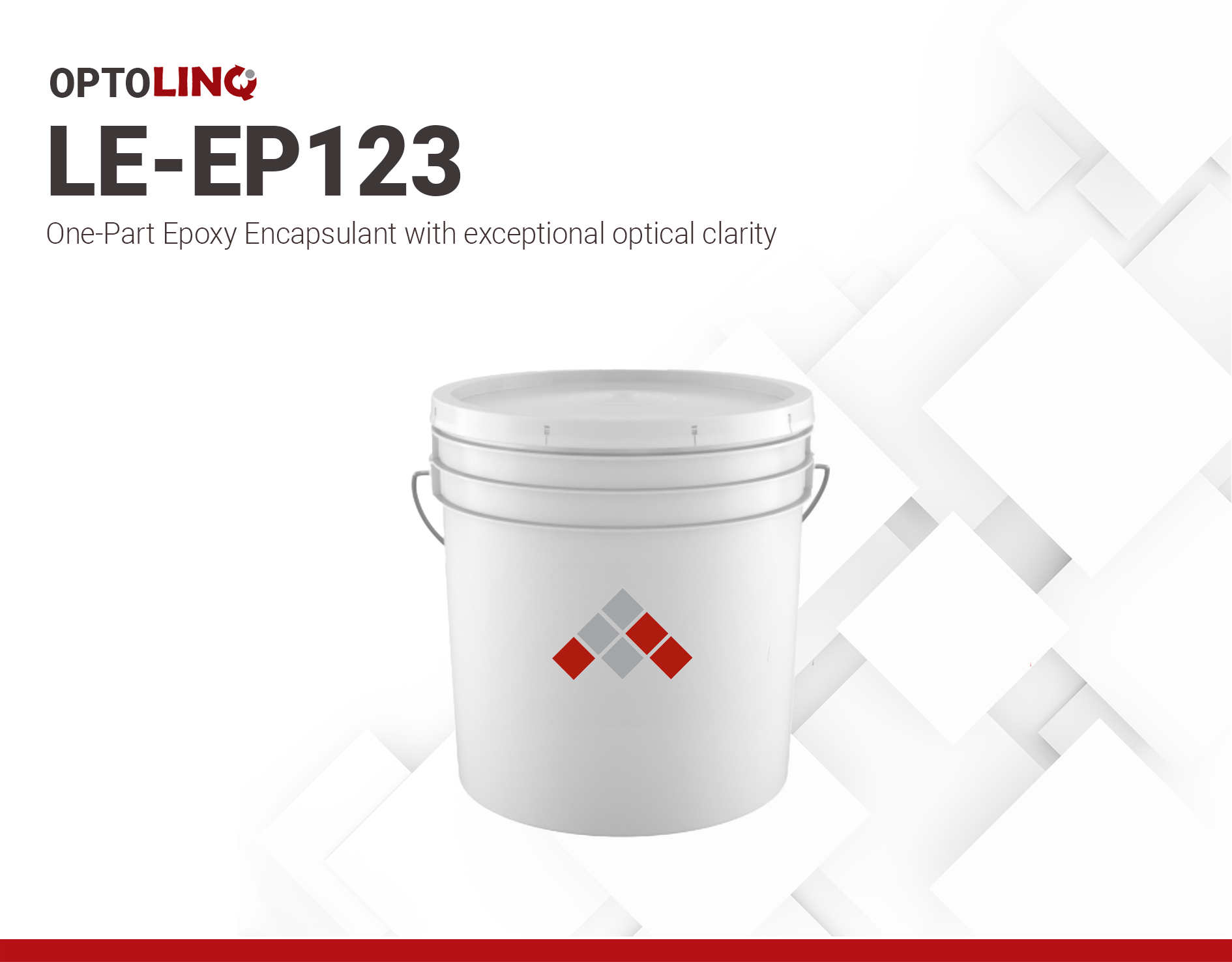OPTOLINQ LE-EP123 | One-Part Epoxy encapsulant
- Excellent thermal stability
- Excellent UV stability
- High light transmittance
Product Description
OPTOLINQ LE-EP123 is a high-performance, single-component epoxy resin that delivers exceptional optical clarity, robust bonding, and thermal stability. It's ideal for demanding applications where light transmission and structural integrity are critical.
OPTOLINQ LE-EP123 offers a wide curing temperature range, excellent anti-sagging properties, and superior high-temperature resistance, making it perfect for prepreg and impregnation processes. LE-EP123 is available with light diffusant depending on customer requirement.
Cure schedule
- 150°C for 1 hour
Technical Specifications
| General Properties | |||||||
| Appearance Appearance Appearance at room temperature. | Colorless | ||||||
| Refractive index Refractive index The refractive index determines how much the path of light is bent, or refracted, when entering a material. It is calculated by taking into account the velocity of light in vacuum compared to the velocity of light in the material. The refractive index calculation can be affected by the wavelength of light and the temperature of the material. Even though it is usually reported on standard wavelengths it is advised to check the TDS for the precise test parameters. | 1.52 | ||||||
| Specific Gravity Specific Gravity Specific gravity (SG) is the ratio of the density of a substance to the density of a reference substance; equivalently, it is the ratio of the mass of a substance to the mass of a reference substance for the same given volume. For liquids, the reference substance is almost always water (1), while for gases, it is air (1.18) at room temperature. Specific gravity is unitless. | 1.00 | ||||||
| Physical Properties | |||||||
| Viscosity Viscosity Viscosity is a measurement of a fluid’s resistance to flow. Viscosity is commonly measured in centiPoise (cP). One cP is defined as the viscosity of water and all other viscosities are derived from this base. MPa is another common unit with a 1:1 conversion to cP. A product like honey would have a much higher viscosity -around 10,000 cPs- compared to water. As a result, honey would flow much slower out of a tipped glass than water would. The viscosity of a material can be decreased with an increase in temperature in order to better suit an application | 15000 mPa.s | ||||||
| Mechanical Properties | |||||||
| |||||||
| Electrical Properties | |||||||
| Visible Light Transmission | >90 % | ||||||
| Thermal Properties | |||||||
| |||||||
| |||||||
| Glass Transition Temperature (Tg) Glass Transition Temperature (Tg) The glass transition temperature for organic adhesives is a temperature region where the polymers change from glassy and brittle to soft and rubbery. Increasing the temperature further continues the softening process as the viscosity drops too. Temperatures between the glass transition temperature and below the decomposition point of the adhesive are the best region for bonding. The glass-transition temperature Tg of a material characterizes the range of temperatures over which this glass transition occurs. | 115 °C | ||||||
Additional Information
...

Precautions for Use
This product needs to be stored at low temperatures and at dry places. The shelf life will vary depending on the storage conditions.
Before use, allow the material to reach room temperature (15–25 °C, 25–55% RH) for at least 2 to 4 hours, ensuring the packaging is unopened to prevent moisture contamination—thawing time of approximately 2 hours for small packaging (30g). for larger quantities, it may take around 4 hours.
Preheat the material at 40-60°C for about 30-60 minutes
Maintain a clean and ventilated workplace with proper ventilation and exhaust system..
Wear appropriate safety equipment before use and avoid direct contact with the body. Please read the Safety Data Sheet (SDS) carefully before using.
- For standard applications using the single-step cure is sufficient and efficient. However for high-performance applications and thermally-sensitive packages and substrate please conduct specific tests to arrive at conditions suitable for the package.
Storage and Handling
Store in a cold, dry, and clean environment, ideally at –10 °C or lower with relative humidity below 70%. Keep away from exposure to direct sunlight. It is strictly forbidden to store in outdoor environments. At proper storage conditions, unopened material has a shelf life of 3 months.



